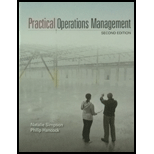
Practical Operations Management
2nd Edition
ISBN: 9781939297136
Author: Simpson
Publisher: HERCHER PUBLISHING,INCORPORATED
expand_more
expand_more
format_list_bulleted
Concept explainers
Question
Chapter 12, Problem 4P
Summary Introduction
Interpretation: Implication of pushing or pulling in lean system is to be determined.
Concept Introduction: Lean operation is a process in which a business should focus on continuous improvement with minimum resources and elimination of wastage. It is a process which is adopted by business to work efficiently and wastage must be reduced to the maximum level. It’s main focus is to create customer satisfaction and eliminate implicit cost. It’s principal is to smoothen manufacturing process so that operation of business can be efficiently done. Moreover, delegation of work is important rather than having work load at the same team so that perfection can be attained.
Expert Solution & Answer
Want to see the full answer?
Check out a sample textbook solution
Students have asked these similar questions
Which of the following statements about organization's strategy is FALSE?
OA. They are formulated after the organization's mission is determined.
OB. They reflect an organization's purpose.
OC. An organization's strategy exploits opportunities and threats.
OD. They help determine how an organization expects to achieve its miss
OE. Each functional area of the organization will have a strategy.
The ability of an organization to match changes in a marketplace where design
volumes fluctuate substantially is:
OA. competing on productivity.
OB. mass production.
OC. time-based competition.
OD. competing on differentiation.
O E. competing on response.
Porter's Five Forces Model is used to evaluate competition based on which 5 asp
A. immediate rivals, potential entrants, customers, suppliers, and substitute
B. potential entrants, customers, suppliers, legal regulations, and cost
please answer
please answer
Chapter 12 Solutions
Practical Operations Management
Ch. 12 - Prob. 1DQCh. 12 - Prob. 2DQCh. 12 - Prob. 3DQCh. 12 - Prob. 4DQCh. 12 - Prob. 5DQCh. 12 - Prob. 6DQCh. 12 - Prob. 1PCh. 12 - Prob. 2PCh. 12 - Prob. 3PCh. 12 - Prob. 4P
Ch. 12 - Prob. 5PCh. 12 - Prob. 6PCh. 12 - Prob. 7PCh. 12 - Prob. 8PCh. 12 - Prob. 9PCh. 12 - Prob. 10PCh. 12 - Prob. 11PCh. 12 - Prob. 12PCh. 12 - Prob. 13PCh. 12 - Prob. 14PCh. 12 - Prob. 15PCh. 12 - Prob. 16PCh. 12 - Prob. 17PCh. 12 - Prob. 18PCh. 12 - Prob. 19PCh. 12 - Prob. 20PCh. 12 - Prob. 21PCh. 12 - Prob. 22PCh. 12 - Prob. 23PCh. 12 - Prob. 24PCh. 12 - Prob. 25PCh. 12 - Prob. 26PCh. 12 - Prob. 27PCh. 12 - Prob. 1.1QCh. 12 - Prob. 1.2QCh. 12 - Prob. 1.3QCh. 12 - Prob. 1.4QCh. 12 - Prob. 2.1QCh. 12 - Prob. 2.2QCh. 12 - Prob. 2.3QCh. 12 - Prob. 3.1QCh. 12 - Prob. 3.2QCh. 12 - Prob. 3.3Q
Knowledge Booster
Learn more about
Need a deep-dive on the concept behind this application? Look no further. Learn more about this topic, operations-management and related others by exploring similar questions and additional content below.Similar questions
- please asnwerarrow_forwardWhat are the obstacles to incorporating stress management techniques? How can we overcome these obstacles?arrow_forwardIn the 2016, "ATB: digital disruption in the parking meter industry" perform a finanacial analysis and make a chart similar to this one 2013 2014 Current Ratio 1.88 1.41 Quick Ratio 0.49 0.29 Debt to Equity 0.95 1.92 Return on Assets 5.47% 2.76% Net Profit Margin 2.71% 1.89%arrow_forward
- Perform a VRIO Analysis on the 2016 "ATB: Digital disruption in the parking meter industry" and make a chart similar to this one V R I O Topic Y Y Y Y Relations with John Deere and Paccar Y N N Y Customer Relations Y Y Y Y Acquisition and Integration Process Y Y Y N Cervus Leadership University Y Y N Y Proactive Management Y Y N Y Financial Position Y N N N Scale of Organizationarrow_forwardHow do incorporated stress management techniques impact future emotional strength and wellness? What are the lesson learned from incorporating stress management techniques in the past that reflects developing emotional resilience?arrow_forwardIn the 2016 "ATB: digital disruption in the parking meter industry" 1. Identification + use of suitable decision criteriato rank options▪ Development of practical options in relation toidentified issue(s) + prior analysis▪ Qualitative + financial evaluation andcomparison of options 2 2. Detailed + practical action to putrecommendations in place (both short & long-run)▪ Timeline of sequence of actions, e.g. Ganttchart▪ Controls + timeline to measure if plan is ontrack▪ Contingency planarrow_forward
arrow_back_ios
SEE MORE QUESTIONS
arrow_forward_ios
Recommended textbooks for you
 Practical Management ScienceOperations ManagementISBN:9781337406659Author:WINSTON, Wayne L.Publisher:Cengage,
Practical Management ScienceOperations ManagementISBN:9781337406659Author:WINSTON, Wayne L.Publisher:Cengage, Operations ManagementOperations ManagementISBN:9781259667473Author:William J StevensonPublisher:McGraw-Hill Education
Operations ManagementOperations ManagementISBN:9781259667473Author:William J StevensonPublisher:McGraw-Hill Education Operations and Supply Chain Management (Mcgraw-hi...Operations ManagementISBN:9781259666100Author:F. Robert Jacobs, Richard B ChasePublisher:McGraw-Hill Education
Operations and Supply Chain Management (Mcgraw-hi...Operations ManagementISBN:9781259666100Author:F. Robert Jacobs, Richard B ChasePublisher:McGraw-Hill Education
 Purchasing and Supply Chain ManagementOperations ManagementISBN:9781285869681Author:Robert M. Monczka, Robert B. Handfield, Larry C. Giunipero, James L. PattersonPublisher:Cengage Learning
Purchasing and Supply Chain ManagementOperations ManagementISBN:9781285869681Author:Robert M. Monczka, Robert B. Handfield, Larry C. Giunipero, James L. PattersonPublisher:Cengage Learning Production and Operations Analysis, Seventh Editi...Operations ManagementISBN:9781478623069Author:Steven Nahmias, Tava Lennon OlsenPublisher:Waveland Press, Inc.
Production and Operations Analysis, Seventh Editi...Operations ManagementISBN:9781478623069Author:Steven Nahmias, Tava Lennon OlsenPublisher:Waveland Press, Inc.

Practical Management Science
Operations Management
ISBN:9781337406659
Author:WINSTON, Wayne L.
Publisher:Cengage,

Operations Management
Operations Management
ISBN:9781259667473
Author:William J Stevenson
Publisher:McGraw-Hill Education

Operations and Supply Chain Management (Mcgraw-hi...
Operations Management
ISBN:9781259666100
Author:F. Robert Jacobs, Richard B Chase
Publisher:McGraw-Hill Education


Purchasing and Supply Chain Management
Operations Management
ISBN:9781285869681
Author:Robert M. Monczka, Robert B. Handfield, Larry C. Giunipero, James L. Patterson
Publisher:Cengage Learning

Production and Operations Analysis, Seventh Editi...
Operations Management
ISBN:9781478623069
Author:Steven Nahmias, Tava Lennon Olsen
Publisher:Waveland Press, Inc.